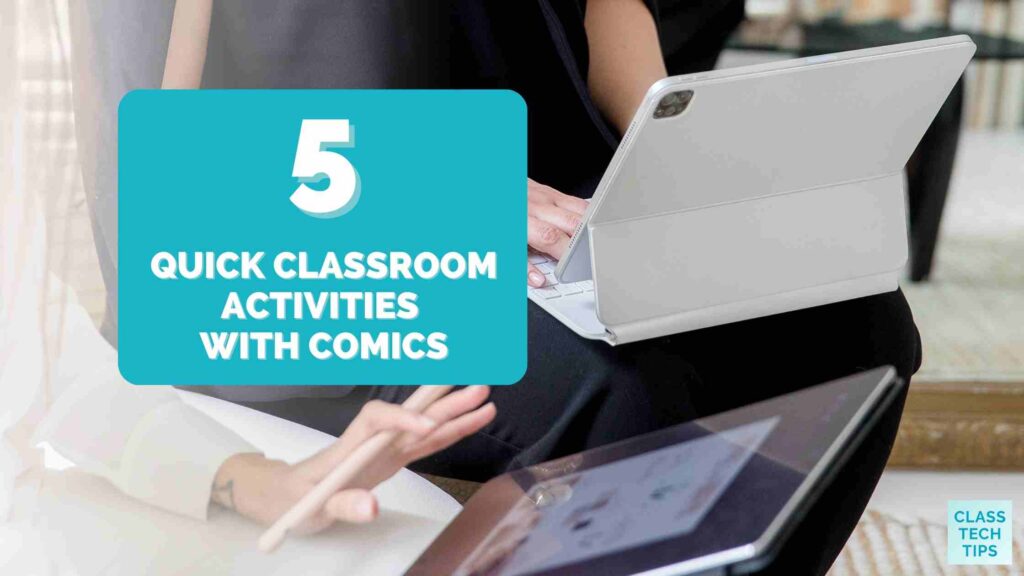Graphic novels and comics are a fun and engaging way to incorporate reading and visual literacy into your next classroom activity. But what exactly are graphic novels? How can you actually use comics in your classroom? There are lots of ways to use comics with students.
You might have explored the popular “Diary of a Wimpy Kid” series by Jeff Kinney or one of the graphic novel examples I listed below. Graphic novels are longer works of fiction or nonfiction that are presented in a comic book format. They include illustrations and text working together to tell a story.
Comics, on the other hand, are shorter works typically found in newspapers or magazines. Both graphic novels and comics can cover a wide range of genres and themes. This could include superhero stories or historical fiction, and even nonfiction explorations of science and social issues.

5 Quick Classroom Activities With Comics
In this blog post, I’ll share some activities and lesson ideas for using graphic novels and comics in the classroom. And I’ll introduce you to a few popular examples of graphic novels suitable for K-12 students of all ages. So whether you’re a seasoned comics reader or new to the genre, I hope you’ll find something useful and inspiring in this post!
Don’t forget to grab my free comic templates here.
Here are five quick and easy ways to use comics in your classroom:
Pre-Reading Activity
Use comics as a pre-reading activity to introduce a new topic or theme. For example, have students read a comic you’ve found that sets the stage for reading. Alternatively, ask students to create their own comics. These can explore the key concepts or ideas that will be covered in the upcoming lesson, such as a comic on ocean animals, before reading about different factors in an ecosystem.

Creative Writing Prompt
Use comics as a creative writing prompt. Have students write a short story or narrative using the panels of a comic strip as a structure. One of my favorite tools for creating comics is Book Creator. You might have caught one of the webinars I’ve hosted for them on how to use this engaging tool.
Summarize Key Ideas
Use comics as a way to summarize or review key information from a lesson. Have students create a comic that illustrates the key points or ideas from the lesson in a fun and engaging way. This is something they can do on their own or as a collaborative activity.
Check for Understanding
Use comics as a form of formative assessment. Have students create a comic that demonstrates their understanding of a concept or idea. You can use it as a basis for evaluating their knowledge. You might provide a checklist for them of information to include for you to figure out how well they understand something.
Boost Collaboration
Use comics as a way to encourage collaboration and teamwork. For example, have students work in groups to create a comic that tells a story or illustrates a concept. Then have them share their comics with the class. This is an excellent way for students to give feedback to one another, too.
Creating Comics and Reading Graphic Novels
If your students love making comics, you may want to introduce graphic novels as an option for independent reading. As I mentioned earlier in the post, graphic novels are a popular form of reading material for students. It’s an excellent genre for student readers for several reasons.
First, graphic novels often have engaging storylines and visually appealing illustrations. These features can help to hold the reader’s attention and make the reading experience more enjoyable. This can be particularly useful for students who may not be as interested in traditional texts or who have difficulty with reading stamina.
Second, graphic novels can be a helpful tool for building specific reading skills. The combination of text and illustrations in graphic novels can provide contextual clues and help students better understand and retain the content they are reading. So if you are teaching context clues, graphic novels might be a format to introduce to students.
Third, graphic novels are a great way to introduce students to a variety of genres and themes. There are graphic novels available in a wide range of styles and subjects, including fiction, nonfiction, fantasy, science fiction, and more. These can help broaden students’ literary horizons and expose them to new ideas and perspectives.
Finally, graphic novels can be a valuable resource for teachers, as they can be used to supplement traditional texts. They also provide an alternative way of presenting information to students. Teachers can use graphic novels to engage students in discussions about themes and characters and to encourage critical thinking and analysis.
Note: Grab my free comic templates here.

Graphic Novels for Students
There are many popular graphic novels that are suitable for elementary and middle school-aged students. Here are a few examples:
- “Diary of a Wimpy Kid” by Jeff Kinney: This popular series follows the adventures of middle schooler Greg as he navigates the challenges of adolescence.
- “Percy Jackson and the Olympians” by Rick Riordan: This series follows the adventures of Percy Jackson, a young demigod who discovers he is the son of Poseidon, and there are graphic novel versions of the popular chapter books.
- “The Baby-Sitters Club” by Ann M. Martin & Raina Telgemeier: This graphic novel series is based on the popular book series of the same name and follows the adventures of a group of middle school friends who start a babysitting business.
- “Amulet” by Kazu Kibuishi: This graphic novel series follows the adventures of Emily and her brother Navin as they journey through a magical world to save their mother.
- “Big Nate” by Lincoln Peirce: This graphic novel series follows the adventures of Nate, a mischievous and energetic sixth grader.
- “Victory. Stand!” by Tommie Smith: In this graphic novel, Tommie Smith looks back on his childhood to his stellar athletic career, including his Olympic podium protest.
- “Unretouchable” by Sofia Szamosi: In this graphic novel, Olive spends the summer before college helping a fashion-industry imaging specialist-and pondering the impact of this work behind the scenes.
By incorporating comics into your lesson plans, you can create a more dynamic and interactive learning environment for your students. Whether you use them as a starting point for discussions, a way to introduce new concepts, or as a tool for assessment, comics can be a valuable addition to any classroom. Give these five quick and easy ways to use comics in your classroom a try, and see how they can enhance your students’ learning and engagement.
Note: This blog post was written with some help from ChatGPT for inspiration and assistance with the writing process. This tool has been in the news, and I’m trying it out to learn more about it and the role of Artificial Intelligence (AI) in education.







